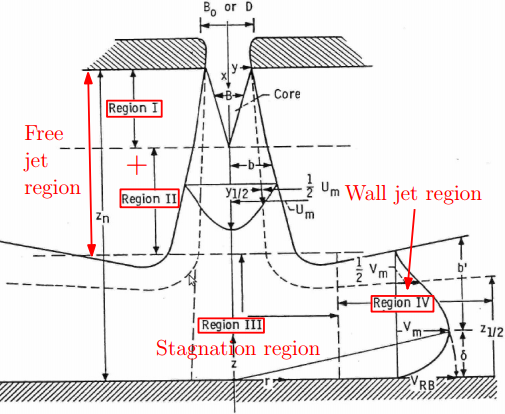Jet flows can be classified in terms of
- the flow conditions (laminar and turbulent)
- the existence of objects: free jet and impinging jet
- the differences of physical properties between a projected fluid and an ambient fluid: submerged jet and unsubmerged jet
- the geometry of a nozzle: round jet and slot jet
and so on.
| Free Jet |
The following video visualizes the flow pattern of a submerged free jet (created by Bjarke Ove Andersen and Mathies Hjorth Jensen of Technical University of Denmark):
| Flow Regions of Impinging Jet [1, 2] |
- Region Ⅰ is the region of flow establishment. It extends from the nozzle exit to the apex of the potential core. The so-called potential core is the central portion of the flow in which the velocity remains constant and equal to the velocity at the nozzle exit.
- Region Ⅱ is a region of established flow in the direction of the jet beyond the apex of the potential core; it is characterized by a dissipation of the centerline jet velocity and by a spreading of the jet in the transverse direction.
- Region Ⅲ is that region in which the jet is deflected from the axial direction.
- Region Ⅳ is known as the wall jet region, where the directed flow increases in thickness as the boundary layer builds up along the solid surface.
– Gauntner et al. [1]
| References |
[1] J. W. Gauntner et al., SURVEY OF LITERATURE ON FLOW CHARACTERISTICS OF A SINGLE TURBULENT JET IMPINGING ON A FLAT’PLATE (accessed 2016-09-04)
[2] T. Dairay, DNS of a turbulent jet impinging on a heated wall (accessed 2016-09-04)
[3] N. ZUCKERMAN and N. LIOR, Jet Impingement Heat Transfer: Physics, Correlations, and Numerical Modeling (accessed 2016-09-04)
[4] Y. M. Chung and K. H. Luo, Unsteady Heat Transfer Analysis of an Impinging Jet (accessed 2016-09-04)
[5] ERCOFTAC Classic Database: Normally-Impinging Jet from a Circular Nozzle
